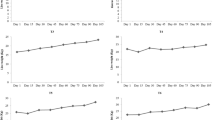Abstract
A 2 × 3 factorial experiment was carried out to evaluate the effect of goat genotypes and different concentrate levels on growth and slaughter characteristics of Small East African × Norwegian crossbred (SEA × N) and Small East African (SEA) goats. The three concentrate levels were T0 (no access to concentrate), T66 (66 % access to ad libitum concentrate allowance) and T100 (100 % access to ad libitum concentrate allowance). Twenty-four castrated goats of each genotype (18 months old with an average weight of 16.7 ± 0.54 kg) were randomly allotted into T0, T66 and T100 treatments. Daily feed intake and fortnight body weight measurements were recorded for the whole 84-day experimental period, after which the animals were slaughtered. Feed intake of T100 animals was 536 g/day, which was 183 g/day higher than that of the T66 group. Supplemented goats (T66 and T100) had significantly (P < 0.05) higher daily gain and body condition score, and better feed conversion efficiency and dressing percentage than T0 goats. The SEA goats had higher (P < 0.05) hot carcass weight (8.2 vs. 7.9 kg) and showed better (P < 0.05) dressing percentage than SEA × N animals. Among supplemented goats, the cost of a 1-kg gain under T66 was Tshs 213/= cheaper than T100 (US$1 ≈ Tshs 1,500). It is concluded that goats should be grazed and supplemented with 353 g concentrate/day for satisfactory fattening performance and higher economic return on investment.
Similar content being viewed by others
References
Alexandre, G. Liméa, L. Fanchonne, A. Coppry, O. Mandonnet, N. and Boval, M., 2009. Effect of forage feeding on goat meat production: Carcass characteristics and composition of creole kids reared either at pasture or indoors in the humid tropics. Asian-Aust. J.Animal. Sci, 22 (8), 1140–1150.
Anaeto, M., Tayo, G.O., Chioma, G.O., Ajao, A.O and Peters, T. A., 2009. Health and nutrition practices among smallholder sheep and goat farmers in Ogun State. http://www.lrrd.org/lrrd21/11/anae21197.htm. Accessed 20 Mar 2013.
Asaduzzaman, M., Alam, M.R., Amin, M.R. and Faruque, M.O., 2009. Comparative study on carcass characteristics between Black Bengal and crossbred goats, Journal of Bangladesh Agricultural University, 7 (1), 87–90.
Association of Official Analytical Chemists (AOAC), 2006. Official Methods of Analysis, 18th ed., AOAC International, Gaithersburg, MD Association of Official Analytical Chemists. Washington, D.C
Hamed, A.H.M. and Elimam, M.E., 2010. Performance and digestibility in Nubian goats fed steam treated Sorghum stover. Pakistan Journal of Nutrition, 9 (3), 298–301.
Kadim, I.T., Mahgoub, O., Al-Ajmi, D.S., Al-Maqbaly, R.S., Al-Saqri, N.M. and Ritchie, A., 2003. An evaluation of the growth, carcass and meat quality characteristics of Omani goat breeds, Meat Science, 66 (1), 203–210.
Langston University, 2000. Goat research extension. Goat ME requirement calculator. http://www2.luresext.edu/goats/research/me2.html.
Legesse, G., Abebe, G. and Ergano, K., 2005. The economics of goats managed under different feeding systems. http://www.Irrd.org/Irrd17/6/lege 17066.htm.
MAFF, 1975. Energy allowances and feeding systems for ruminants, Ministry Agriculture and Fisheries. Food Technology Bulletin.Volume 33 (London).
Mellaku, S., and Betsha, S., 2008. Body weight and carcass characteristics of Somali goats fed hay supplemented with graded levels of peanut cake and wheat bran mixture, Tropical Animal Health and Production, 40, 553–560.
Mushi, D.E., Safari, J., Mtenga, L.A., Kifaro, G.C. and Eik, L.O., 2009. Effects of concentrate levels on fattening performance, carcass and meat quality attributes of Small East African x Norwegian crossbred goats fed low quality grass hay, Livestock Science, 124 (1), 148–155.
SAS, 2002. Statistical Analysis System. Users guide, Version 9.2. SAS Institute, Inc, arry. NC.USA.
Van soest, P.J., Robertson, J.B. and Lewis, B.A., 1991. Methods for dietary fibre, neutral detergent fibre and non starch polysaccharides in relation to animal Nutrition, Journal .Dairy Science, 74 (10), 3583–3597.
Acknowledgments
The authors wish to thank SUA-PANTIL project 020 and the German Academic Exchange Service (DAAD) for the financial and technical support of this project.
Author information
Authors and Affiliations
Corresponding author
Rights and permissions
About this article
Cite this article
Hozza, W.A., Kifaro, G.C., Safari, J.G. et al. Effect of concentrate supplementation levels on growth and slaughter characteristics of SEA and SEA × Norwegian goats under on-farm conditions. Trop Anim Health Prod 45, 1789–1794 (2013). https://doi.org/10.1007/s11250-013-0436-x
Accepted:
Published:
Issue Date:
DOI: https://doi.org/10.1007/s11250-013-0436-x



